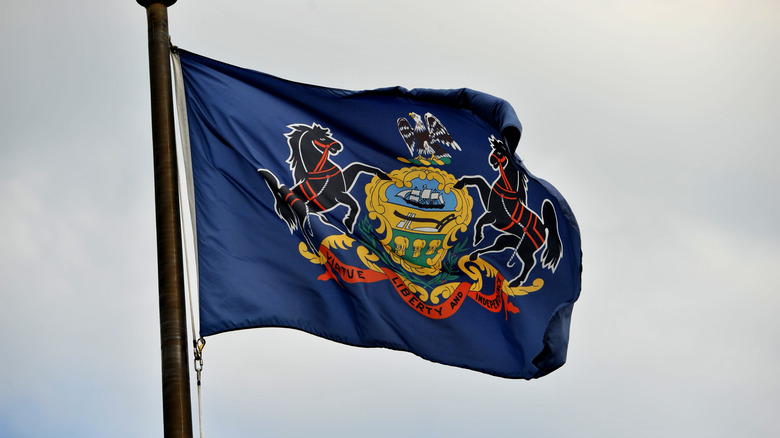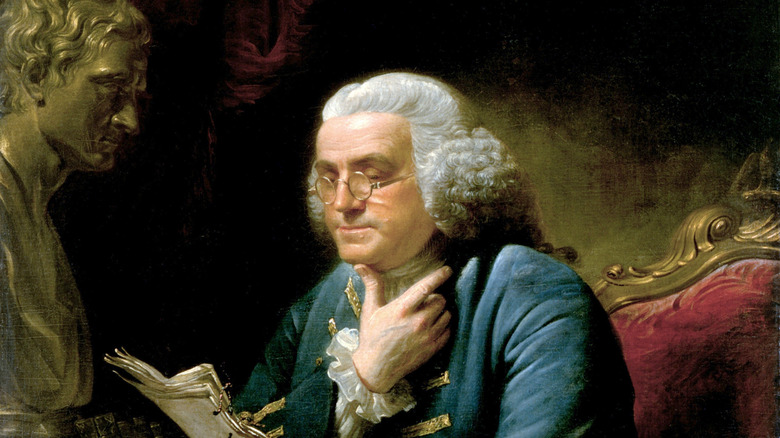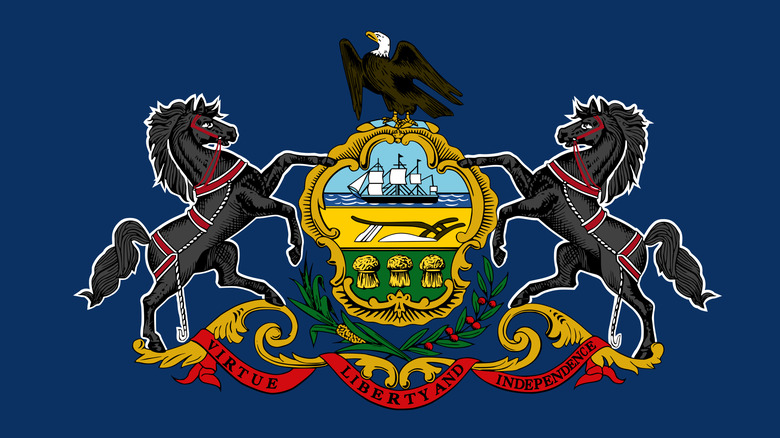The Meaning Of Pennsylvania's State Flag Explained
Pennsylvania has had a long and storied history since its colonial founding nearly 350 years ago. It's one of the original 13 colonies and could rightly be called the birthplace of American democracy since Philadelphia hosted the first and second Continental Congresses. It was there that the Founding Fathers birthed both the Declaration of Independence and the U.S. Constitution. They call Pennsylvania the Keystone State for this very reason. With all that history under its belt, you may be surprised to learn Pennsylvania didn't officially adopt a state flag until much later.
It wasn't until 1907 that the Pennsylvania General Assembly authorized the creation of an official state flag for civilian use. The stipulations included having a field of dark blue the same color as that found on the U.S. flag, with the state coat of arms at the flag's center, and yellow silk knotted fringe trimming it. While this state flag is less than 120 years old, the seal that adorns it is much older. And it's here where you'll find symbolism concerning various aspects of Pennsylvania's history and importance, from a black ship representing the state's commerce to a plow standing for Pennsylvania's rich natural wealth.
Precursors to Pennsylvania's state flag
It may have taken the Pennsylvania General Assembly a long while to create an official state flag, but that doesn't mean there weren't other earlier flags associated with the colony and state. William Penn established Pennsylvania in 1682 as a place for Quakers, and during its time as a colony, there's no evidence it had any sort of official flag. However, Benjamin Franklin designed some Pennsylvania-related flags in the mid-1700s. Franklin was famous for his various inventions, from bifocal glasses to a type of stove, but he also dabbled in flag design. He created several military flags, including one that's used today by the Pennsylvania National Guard unit he founded.
However, it was the creation of the Pennsylvania coat of arms in 1779 that played an important part in the eventual look of the state flag. Caleb Lownes, a Philadelphia engraver, designed the original that began appearing on various state militia flags 20 years after Lownes created it. In 1799, the Pennsylvania General Assembly allowed the militia to use the coat of arms on its flags, which included a regimental version with the coat of arms on a blue field (along with other components) that heavily influenced the state flag's design.
What the various elements of the Pennsylvania state flag mean
Unlike the creation of the Texas state flag, which includes such mysteries as why it resembles the Chilean flag or who actually came up with the final design, Pennsylvania's is much more straightforward. The state coat of arms in the center of the flag includes an American eagle sitting atop a shield, signifying Pennsylvania's loyalty to the U.S. On either side of the shield, two black draft horses in harness rear up on their hind legs and hold the shield. Directly below the shield is a stalk of Indian corn and an olive branch, representing the state's past and future. At the bottom is a red ribbon with the state motto: "Virtue, Liberty, and Independence."
Inside the shield, there are three parts with the aforementioned ship representing the state's extensive trade. Below that is the plow and three wheat sheaves at the bottom, signifying Pennsylvania's important natural resources. The wheat also represents the state's intellectual wealth and human action. So the next time you see the Keystone State's flag waving in the breeze you'll know what all its components stand for.


